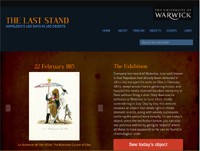Rebecca Young: What was the overarching aim of this project?
Katherine Astbury: The idea for an online exhibition arose out of a chat over coffee in the autumn of 2013 between Mark Philp, newly arrived in the History department at the University of Warwick with the remit of creating a European History Centre, and the team members of an Arts and Humanities Research Council-funded project on French Theatre of the Napoleonic Era based in French Studies: Katherine Astbury, Katherine Hambridge, Clare Siviter and Devon Cox.
 We decided we really ought to do something to mark the bicentenary of Waterloo but put the battle into context, and move away from the traditional British focus on the ‘duel' between Napoleon and Wellington.
We decided we really ought to do something to mark the bicentenary of Waterloo but put the battle into context, and move away from the traditional British focus on the ‘duel' between Napoleon and Wellington.
In the words of Mark Philp: “We hope what we've provided is a nuanced, broader picture of the events leading to the Battle of Waterloo and the ramifications of these events on the political landscape. Whereas by 1814, most of Europe thought the radicalism of the French Revolution had finally been contained, the 100 Days showed that a monarchy couldn't simply be restored by European alliance as if nothing had happened. When Napoleon escaped from Elba and landed in France in February 1815, he did so by presenting himself not as an autocrat, but as a popular hero: he could, as Balzac later put it, ‘gain an empire simply by showing his hat'! By moving beyond the largely military terms of the usual discussion of 1815, this exhibition draws attention both to civilian and popular responses to this dramatic period, and its implications for the political landscape of Europe.”
Rebecca Young: The list of objects is calibrated very carefully to the specific dates. Could you tell us how you decided on which object for which date?
Katherine Astbury: The project began very simply with a call for papers for a day conference on the 100 days with a view to seeing what colleagues who work on Napoleon wanted to focus on. We were inundated with responses – perhaps because we only asked for 10-minute presentations – but from the 24 speakers last July we were able to start creating a timeline. Some contributions were very clearly related to a specific day, others were less precisely dated but we started attributing dates that seemed to fit the topic. We then added in dates relating to our research into theatre and after that took stock: we looked at what we had and where there were still gaps – very few colleagues had offered a royalist perspective for instance so we found events/objects/ dates where we could cover Louis XVIII. We also went looking for colleagues who could provide Polish, Russian and Caribbean angles on the 100 days as we wanted to give exposure to responses from a variety of locations. We also ask Tim Clayton, co-curator of the British Museum exhibition on Bonaparte and the British, to join the curatorial team to suggest how we might provide variety in the objects and the narratives. Some of our undergraduates and MA students also took up the challenge to find aspects of the 100 days that interested them and we're delighted that they feature in the exhibition alongside contributions from eminent Napoleonic scholars.
We came to see the periods either side of the traditional 100 days (that is the month from Napoleon leaving Elba to arriving in Paris, and the weeks after the battle of Waterloo) as at least as interesting and important as the time when he was in power and we realised that we were in fact going to end up with far more than 100 objects for the 100 days (whatever the title of the exhibition might say!).
Rebecca Young: Is this online exhibition “The last Stand Napoleon’s 100 days in 100 objects” aimed at a particular audience? What sort of feedback have you had?
Katherine Astbury: We wanted the exhibition to be accessible to as wide an audience as possible so we encouraged colleagues to write just 200 words to go alongside the object, and have tried to provide a summary of each week and contextual information so that it can be enjoyed by the general public and school pupils.
Feedback has been extremely positive, though the editor of a history magazine in France suggested that we shouldn't be calling it an exhibition if those viewing it can't choose when and how they see it… However, we steadfastly stand by our decision to release an object per day because it allows a 21st-century audience the chance to relive, in real time, the uncertainty of the period and the drama as it unfolds – in our age of instant information, it serves as a reminder that in 1815 there was often a substantial time lag between events and news of those events. And visitors to the website can see all previous days (go to objects on the home page) so it's not as though we're forcing people to visit every day (though I know some are!)
Rebecca Young: Do you think it is the place of universities to produce “public history”?
Katherine Astbury: We work in a public university and our research is funded by public money so it makes sense that we share the results of that research as widely as possible and in formats that might be accessible.
Rebecca Young: The project is clearly very collaborative. Did you, as one of the editors, aim to give it a specific direction? Did you try to lead the general argument or did you allow the individual contributors to choose their line of argument?
Katherine Astbury: We told contributors that we wanted to look at popular responses to Napoleon from as many national standpoints as possible but other than that gave our contributors no steer at all – they were free to take whichever angle they liked. Inevitably, of course, in the choices we have made of what to include to fill gaps we have ended up shaping the direction but we hope we've created a balanced account of the 100 days from a variety of perspectives.
Rebecca Young: Since it is a very European project by the very nature of its subject, did you regret not having the content available in other languages?
Katherine Astbury: French colleagues wrote their entries in French and these are available for people to read in the original. We would of course have loved to have had the site as – at the very least – a bilingual English-French exhibition but we haven't had the time or the resources to achieve that. One of the advantages of an online exhibition which reveals entries day by day is that not everything has to be ready by the launch date; the disadvantage is that there are still a number of entries to write…
Rebecca Young: Do you envisage leaving this resource online permanently?
Katherine Astbury: We intend to leave the exhibition online. Without the generosity of all the museums and collections involved, this exhibition wouldn't have been possible but some have asked us to remove their images at the end of the project in July. Those entries will then have a link to the object on the host institution's webpages, or an alternative image.
Rebecca Young, June 2015.
The online exhibition “Napoleon's Last Stand: 100 days in 100 objects” is visible here.


